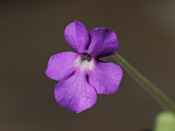Cultivation
Pinguicula
This genus is something for true flower fans, since the plants bloom almost continuously in all imaginable colors.
Just like the species of the genus Drosera, Pinguicula catch their prey with the help of adhesive droplets.
The leaves are completely covered with drops, which causes the plants to shine in the sun. Some (Mexican) species form a winter rosette in winter,
in which they can retreat to survive the dry season. Some temperate species can also be kept outside in a bog garden.
Here are some species in detail:
Mexican species
Light: bright
Humidity: >60 %
Temperature: Summer 20-25 °C, colder during winter
Substrate: Peat-sand-perlite mixture
Watering: Pot always in about 1 cm of water or less, drier during winter
Propagation: Leaf cuttings, seeds
Pinguicula cyclosecta
My own experience:
I had no problems with this plant from the beginning. It has also flowered several times, but unfortunately the seeds I obtained did not germinate.
In winter it formed a winter rosette and started to sprout again in spring. After the hibernation, the plant surprisingly split.
By the way, its favorite prey were black gnats.
In the summer of next year, I placed the plant on the balcony along with a few other plants. A few hours later there was an extreme storm.
It was all over in 10 minutes. Much of the substrate was washed away. Pinguicula cyclosecta was hit the worst.
It fell apart completely and then consisted only of individual parts. But the individual leaves became leaf cuttings a few days later.
Many small plants were formed from these after a short time.
Level of difficulty: 


Pinguicula laueana
My own experience:
This plant behaves similarly to Pinguicula cyclosecta, but unfortunately it does not grow quite as quickly.
But it also produced a winter rosette in winter. Unfortunately, it was so tiny that it eventually died. The special thing about this species is the red flower, by the way.
After a while I bought a new plant and was rewarded with a flower.
Level of difficulty: 


Pinguicula 'Sethos'
My own experience:
This hybrid was one of my first plants. The plant is relatively easy to cultivate and also flowers quite often.
The first time I repotted it, I quickly noticed that it has white, relatively short roots (like many other Pinguicula). But this plant is very tough.
For me it grows on the north side as well as on the south side and divides there several times after flowering. This way it can be multiplied very easily.
Level of difficulty: 




